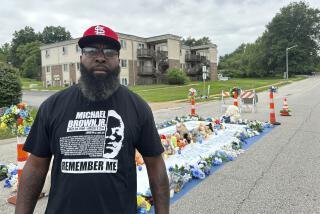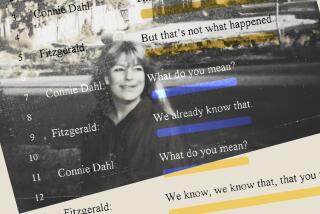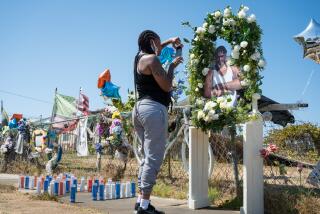Ferguson grand jury faced confusing, contradictory information
Halfway through his testimony to a secret grand jury, Ferguson police Officer Darren Wilson talked about the confusion that engulfed him as Michael Brown’s body sprawled lifeless and bloody across the double yellow lines of Canfield Drive.
“I think I’m just kind of in shock of what just happened,” said the 28-year-old who pulled the trigger that hazy August Saturday, igniting months of angry demonstrations and a nation’s worth of soul searching. “I really didn’t believe it, because like I said, the whole thing started over, ‘Will you just walk on the sidewalk?’ and it developed into that in 45 seconds.”
The confusion, however, was just beginning. The seven men and five women who declined to indict the officer were confronted with a mind-numbing array of conflicting testimony, autopsy reports, reluctant witnesses, gruesome details and difficult questions.
Was the unarmed 18-year-old black man with marijuana in his system the gun-grabbing “demon” described by the frightened officer who shot him dead? Or was he the victim of a cop who one eyewitness said fired his gun “very unjustly; he overkilled, basically”?
What happened in Wilson’s police-issued Chevy Tahoe that caused the officer to draw his gun? Was Brown, whose strength reminded Wilson of Hulk Hogan, running away when he was shot, or was he charging at the smaller man? Were his hands up in surrender or clenched in threat?
Some who testified changed their stories as the investigations into the death and culpability progressed. Others were unreliable from the start, such as the bipolar man with a head injury and faulty memory who has refused most medication since 1988.
Wilson’s testimony, according to documents from the grand jury proceedings, was detailed and emphatic — “I had to kill him,” he said he told his sergeant shortly after the shooting. But it also was self-serving, St. Louis County prosecutor Robert McCulloch noted when announcing the grand jury’s decision.
“The target or the suspect has the most interest in the case,” McCulloch said. “We don’t put a whole lot of stock in, can’t rely solely on that testimony.”
None of the jurors has spoken publicly, and most names and identifying details have been stripped from the thousands of pages of grand jury testimony — about 70 hours long, involving 60 witnesses. So it is difficult to figure out just how the panel reached its decision.
But on Tuesday, at least three facts cannot be assailed. Brown is dead. Wilson killed him. And the police officer is a free man.
::
Wilson was leaving an earlier call Aug. 9 to assist the mother of a sick infant when he saw Brown and another young man walking down the middle of the street, forcing traffic to slow and swerve around them.
The police officer told the grand jury that he drove up, stopped his car and asked Brown, “What’s wrong with the sidewalk?”
In Wilson’s account, it was all downhill from there.
Brown swore at the officer and the two men walked away. So Wilson called for backup, threw the Tahoe into reverse and cut the young men off.
Wilson testified that as he opened the vehicle’s door, Brown slammed it shut on the officer’s leg. Wilson said he told Brown to get back and opened the door again.
“He then grabs my door again and shuts my door,” Wilson told the grand jury. “At that time is when I saw him coming into my vehicle.... I was hit right here in the side of the face with a fist.”
The two men scuffled, Wilson said, and he struggled to gain some control over the situation “and not be trapped in my car any more.” He grabbed Brown’s arm. He drew his gun. He told Brown to get back or he would shoot.
Brown “immediately grabs my gun and says, ‘You are too much of a pussy to shoot me,’” the officer recounted to the grand jury.
Wilson said he pulled his gun because “I felt that another one of those punches in my face could knock me out or worse. I’d already taken two to the face, and ... the third one could be fatal if he hit me right.”
One witness, who was in his second-floor apartment and heard the initial tussle on the street outside, said he looked out his window and saw Brown’s and Wilson’s arms flailing at the officer’s car door.
“Really not sure if, um, Mike Brown was punching on him or if the officer was grabbing on him,” said the unidentified witness, who was interviewed several times by police and the FBI. “But something was going on through the window.
“It just didn’t look right.”
::
One of the central questions the grand jury had to resolve: Was Brown charging at Officer Wilson?
Wilson told the grand jury that after Brown attacked him in his car, he chased him away, yelling for Brown to get on the ground, and then he saw him turn.
“When he looked at me, he made like a grunting, like aggravated sound and he starts, he turns and he’s coming back towards me,” Wilson said.
“I keep telling him to get on the ground; he doesn’t.”
Wilson said he fired a few shots, saw Brown “jerk” and “flinch” but “he’s still coming at me, he hadn’t slowed down.” He kept shooting, but that didn’t deter Brown.
Wilson said he was “backpedaling,” afraid that, “if he reaches me, he’ll kill me.”
“He started to lean forward as he got close, like he was going to just tackle me, just go right through me,” he said.
So Wilson said that, at that point, “all I see is his head and that’s what I shot.”
Some witnesses backed up his account of the shooting.
One man, “identified only as Witness 10, was working in the vicinity of the nearby Canfield Green apartment complex at the time of the shooting and told the grand jury that he saw Brown turn around and head toward Wilson twice, “in a tackle motion charge.”
Even as Wilson fired, the witness said, according to the grand jury documents, Brown “was coming in a charging motion still and the final rounds were being fired within a charging motion and that’s when he collapsed.”
But other witnesses were adamant, even during cross-examination by prosecutors, that Brown never charged the officer.
An elderly man who lives in the Canfield Green complex and witnessed the shooting from his porch contended during lengthy questioning by investigators and prosecutors that Brown was not shot in the back or charging the officer but was instead “steadily moving” toward him, “staggering,” wounded and “wobbly” before the final fatal shot to his head.
“He was not charging him, he was defenseless, hands up, he was trying to stay on his feet and you could see that his knees was beginning to buckle, he was going down,” the man told the grand jury. He said he saw Brown’s torso bent 45 degrees as he was “fighting to stay up.”
“He wasn’t going toward the officer to try to get him. He was trying to stand up. He was trying to maintain himself, but you could see his body was giving out,” the man said, adding that when he saw the final shots fired, Brown “was already on his way down.”
::
Witness 12 was certain that Brown had his hands up when Wilson shot him.
But he testified that he couldn’t explain how he knew.
As the resident of Canfield Green told investigators during one of three interviews in the days after Brown’s death, he did not actually see where Brown ran as shots rang out.
“Like I said, he musta got hit,” the witness said, according to the grand jury documents, “and he, he probably had his hands up when he got hit.”
The location of Brown’s hands — held high in surrender, at his waistband, or balled up in fists in front of him like a fighter ready to brawl — was key to the case. But the grand jury heard little agreement on this point.
A woman who was getting ready to leave for work that day said she saw Brown turn around and face Wilson with his hands up and his palms facing the officer. Wilson fired anyway, she said.
“I never saw him make any more movements,” she said. Brown “fell on his knees and he hit his face on the ground.”
But one witness who was at the apartment complex dropping off some equipment said Brown did not have his hands in the air and was possibly yanking his pants up before charging at Wilson.
Asked where Brown’s hands were, the witness replied: “I know for sure they weren’t above his head.”
Autopsy reports added to the mix of possible scenarios: Brown’s position when he was shot, and whether drugs could have affected his behavior the day Wilson rolled up beside him on the street.
The chief toxicologist for St. Louis County testified that Brown had a “very significant dose” of marijuana in his system.
“Technically speaking, I mean, you are not looking at pretty birds and flying snakes and so forth, but you are altering your perception of sense,” he said, in describing how that much marijuana might affect someone.
But the toxicologist could not say how the drug might have affected Brown, if at all. “How he would have behaved and what he would have done, I cannot predict,” he said.
There was little dispute between the two autopsy reports provided to jurors. One was done by St. Louis County. The other was done by Michael Baden, a nationally known forensic pathologist, at the family’s request.
Both concluded that Brown was shot in the head, face, chest area and arms.
The county report was more detailed, describing each wound as either an entry or exit wound but not speculating on how they might have occurred.
It noted that Brown had been shot twice in his right arm, in addition to suffering wounds to his head and chest and graze wounds to his right biceps and thumb.
Baden’s report said Brown’s head wounds indicated that he must have been facing Wilson when he was shot, with his head lowered and his face near parallel to the ground. The Baden report also said a wound to Brown’s right hand came from a bullet fired at very close range.
That would seem to bolster the accounts of a struggle in the police car.
Baden, however, noted that he was not able to do his autopsy until Aug. 17, after Brown had been embalmed. Embalming, he testified, changes the look of wounds.
And adds to the confusion.
Times staff writer Kurtis Lee contributed to this report.
More to Read
Sign up for Essential California
The most important California stories and recommendations in your inbox every morning.
You may occasionally receive promotional content from the Los Angeles Times.













